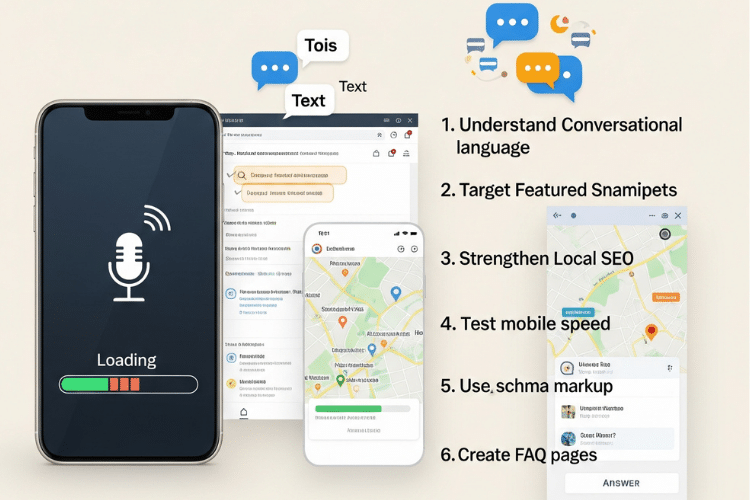Optimizing for Voice: A Marketer’s Guide to Voice Search in 2025
Optimizing for Voice: A Marketer’s Guide to Voice Search in 2025
In 2025, smart assistants have become an indispensable part of our lives, and consumers are now accessing information not just by typing, but by speaking. Voice search is fundamentally changing the customer journey, creating brand new opportunities and challenges for marketers. This guide offers a strategic roadmap for your brand to stay one step ahead in the voice search revolution and achieve success in this new domain.

Voice vs. Text Search: Key Differences in User Intent and Query Language

While short keywords are generally used in keyboard searches (e.g., “Istanbul weather”), complete sentences and natural language are preferred in voice searches (e.g., “Hey Google, is it going to rain in Istanbul tonight?”). This indicates that voice searches typically carry a more specific user intent; users need immediate information or a quick action. Therefore, marketers should focus their strategies on long-tail keywords and question formats that their customers might ask in natural conversational language, rather than on short keywords. For example, a recipe website can more effectively reach voice search users by optimizing its content for queries like “what is an easy homemade chocolate cake recipe?” instead of just “cake recipe.” This approach ensures your brand responds to the real needs of its target audience.
The Power of “Near Me”: Optimizing for Local Voice Search to Drive Foot Traffic

A large percentage of voice searches carry a local intent, such as “best coffee shop near me” or “where is the nearest pharmacy.” For this reason, local SEO is the cornerstone of a voice search strategy, especially for businesses with physical stores. It is vital that your Google Business Profile is complete and up-to-date, containing correct information like address, business hours, and phone number. For instance, if you run a restaurant in Istanbul, including your menu, popular hours, and current customer reviews in your profile enables voice assistants to recommend you to potential customers. Additionally, ensuring your contact information (Name, Address, Phone – NAP) is consistent across all online platforms and regularly collecting positive customer reviews directly impacts your ranking in local voice search results.
The Battle for Position Zero: How to Secure Featured Snippets for Voice Answers

Voice assistants usually provide a single, clear answer to users’ questions, and they typically pull this answer from the “Featured Snippet” box at the very top of Google’s search results. Competing for this “Position Zero” means being heard with your brand’s voice in voice searches. For example, a finance blog answering the question “how to apply for a credit card?” can increase its chances of appearing in this spot by structuring the answer in numbered steps or a short, clear paragraph. Using questions that users might ask directly as headings (H2, H3) in your content and providing a clear answer immediately below is an effective tactic that makes it easier for Google to select your content as a snippet. This strategy also helps to position your brand as an authority on a specific topic.
The Rise of V-Commerce: Preparing Your Business for Voice-Activated Shopping

Voice Commerce (V-Commerce) is when consumers shop via voice commands through smart speakers or phone assistants. In 2025, this trend is growing rapidly, especially in areas like re-ordering frequently consumed products. For instance, users can shop quickly via Amazon Alexa by saying, “order my usual detergent.” To prepare for this new channel, e-commerce businesses need to clearly structure their product data with schema markup. This configuration allows voice assistants to easily understand and present information like product name, price, and stock status to the user. For rapid delivery and ordering apps like Getir or Yemeksepeti, integrating the ability to re-order favorite products or past orders with voice commands can offer a significant competitive advantage and user convenience in 2025.
Building Your 2025 Voice Search Strategy: A Practical Checklist for Marketers

Here is a practical checklist you can start implementing immediately to build your 2025 voice search strategy:
- Understand Conversational Language: Think about what questions your customers might ask about your brand or products and in what kind of language, then shape your content according to these queries.
- Target Featured Snippets: Create content structured with short, clear answers and lists for the most common questions.
- Strengthen Your Local SEO: Keep your Google Business Profile complete and up-to-date, and encourage customer reviews.
- Test Your Mobile Speed: Make sure your website loads at lightning speed on mobile devices, as most voice searches are performed on mobile.
- Use Schema Markup: Guide search engines by implementing structured data markup for content types like products and businesses.
- Create FAQ Pages: Prepare content-rich and comprehensive Frequently Asked Questions pages dedicated to the most common queries. These steps will build a solid foundation for your brand to succeed in the age of voice search.









